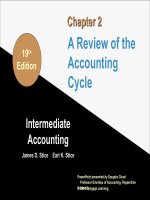MicroEconomics 5e by besanko braeutigam chapter 02
Bạn đang xem bản rút gọn của tài liệu. Xem và tải ngay bản đầy đủ của tài liệu tại đây (618.1 KB, 42 trang )
Chapter 2
Demand and Supply Analysis
Chapter Two Overview
1.Motivation – U.S. corn markets
3.Competitive Markets Defined
5.The Market Demand Curve
7.The Market Supply Curve
9.Equilibrium
6.
Characterizing Demand and Supply –
Elasticity
7.
Back of the Envelope Techniques
Chapter Two
Motivations
Example: U.S. Corn Market
Historical price:
$2.00 per bushel
2003-2004: Prices rose to $3.00 per bushel
2004-2005: Prices fell below $2.00 per bushel
2006-2008: Prices rose above $5.00 per bushel
2008-2009: Prices fell to $3.90 per bushel
Why do prices vary so much?
Changes in Supply and Demand conditions affects
pattern of prices
Chapter Two
Motivations
Example: U.S. Corn Market
• 2002-2003
• Decrease in supply due to drought in the corn-growing
states
• 2004-2005
• Unexpectedly large U.S. corn crops
• 2006-2008
• Changes in U.S. government policy
• Bubble years
• Increase in production costs due to oil price increases and
rains and flooding wiped out corn crop
• 2008-2009
• Weather conditions back to normal
• Economic Crisis
Chapter Two
Competitive Markets
Defined:
Competitive Markets are those
with sellers and buyers that are
small and numerous enough that
they take the market price as
given when they decide how
much to buy and sell.
Chapter Two
The Market Demand Function
Defined:
The Market Demand Function tells us
that the quantity of a good all
consumers in the market are willing to
buy is a function of various factors.
Chapter Two
Market Demand
• Derived Demand
• The part of demand for a good that is derived
from the production and sale of other goods.
• Direct Demand
• The part of demand for a good that comes
from the desire of buyers to directly consume
the good itself.
Chapter Two
The Market Demand Curve
Defined:
The Market Demand Curve plots the
aggregate quantity of a good that
consumers are willing to buy at different
prices, holding constant other demand
drivers such as prices of other goods,
consumer income, quality.
Chapter Two
The Law of Demand
Defined:
The Law of Demand states that the
quantity of a good demanded decreases
when the price of this good increases.
Chapter Two
Demand Curve Rule
Defined:
A move along the demand curve for a
good can only be triggered by a change in
the price of that good. Any change in
another factor that affects the
consumers’ willingness to pay for the
good results in a shift in the demand
curve for the good.
Chapter Two
Shifts of the Demand Curve
The Demand Curve shifts when factors other than own
price change
If the change increases the willingness of consumers to
acquire the good, the demand curve shifts right
If the change decreases the willingness of consumers to
acquire the good, the demand curve shifts left
Chapter Two
The Demand for Cars
Chapter Two
The Demand for Cars
Note:
We always graph P on vertical axis and Q on horizontal axis, but
we write demand as Q as a function of P… If P is written as
function of Q, it is called the inverse demand.
Markets defined by commodity, geography, time.
Chapter Two
Market Supply
The Market Supply Function:
Tells us that the quantity of a good
supplied by all producers in the market
depends on various factors
The Market Supply Curve:
Plots the aggregate quantity of a good that
producers are willing to sell at different
prices.
Chapter Two
Supply Curve for Wheat
Chapter Two
The Law of Supply
Defined:
The Law of Supply states that the
quantity of a good offered increases
when the price of this good increases.
Chapter Two
Supply Curve Rule
Defined:
A move along the supply curve for a good
can only be triggered by a change in the
price of that good. Any change in another
factor that affects the producers’
willingness to offer for the good results in
a shift in the supply curve for the good.
Chapter Two
The Law of Supply
The Supply Curve shifts when factors other than own price change
If the change increases the willingness of producers to
offer the good at the same price, the supply curve shifts
right
If the change decreases the willingness of producers to
offer the good at the same price, the supply curve shifts
left
Chapter Two
Market Equilibrium
• Market Equilibrium
• is a price such that, at this price, the quantities
demanded and supplied are the same.
• is a point at which there is no tendency for the market
price to change as long as exogenous variables remain
unchanged.
Demand and supply curves intersect at equilibrium
Sup
p
nd
a
m
De
ly
Chapter Two
Example: Market Equilibrium for Cranberries
Qd = 500 – 4p
Qs = -100 + 2p
p = price of cranberries (dollars per barrel)
Q = demand or supply in millions of barrels per year
The equilibrium price of cranberries is calculated by equating demand to supply:
Qd = Qs … or…
500 – 4p = -100 + 2p …
solving
p* = $100
Plug equilibrium price into either demand or supply to get equilibrium quantity:
Q* = 500 – 4(100) = 100 units
Chapter Two
Market Equilibrium for Cranberries
Q* = 100
Chapter Two
Excess Demand/Supply
Excess Demand: A situation in which the quantity demanded
at a given price exceeds the quantity supplied.
Excess Supply: A situation in which the quantity supplied at a
given price exceeds the quantity demanded.
If there is no excess supply or excess
demand, there is no pressure for prices to
change and thus there is equilibrium.
When a change in an exogenous variable
causes the demand curve or the supply curve
to shift, the equilibrium shifts as well.
Chapter Two
Excess Demand/Supply
Excess supply
when price is $5
Price (dollars
per bushel)
S
5.00
E
4.00
3.00
Excess demand
when price is $3
8
9
D
11 13 14
Quantity (billions of bushels per year)
Chapter Two
Shifts in Demand, Supply Unchanged
Demand Increases:
P↑ Q↑
Demand Decreases:
P↓ Q ↓
Shifts in Supply, Demand Unchanged
Supply Increases:
P ↓ Q↑
Supply Decreases:
P↑Q↓









